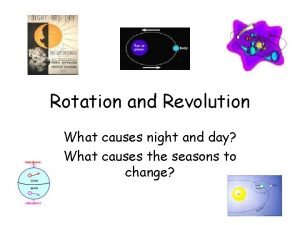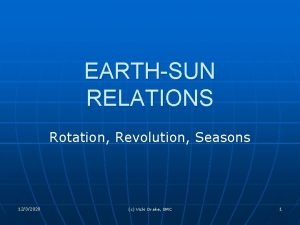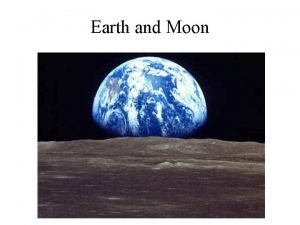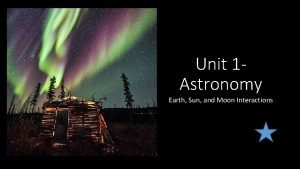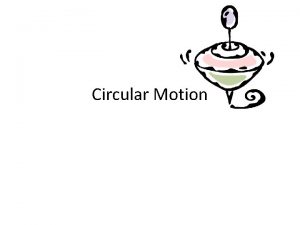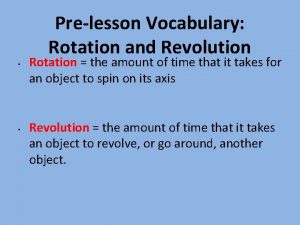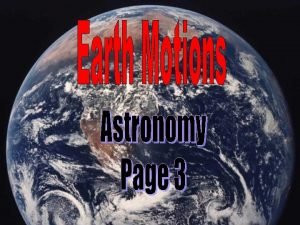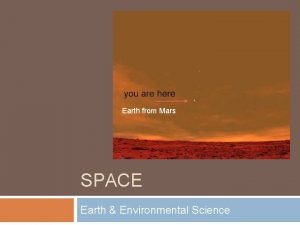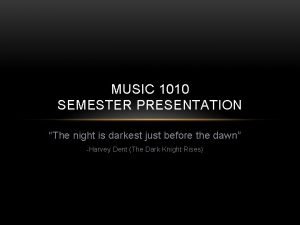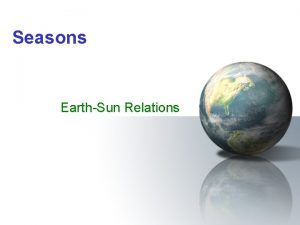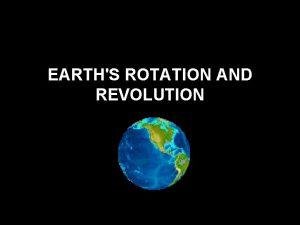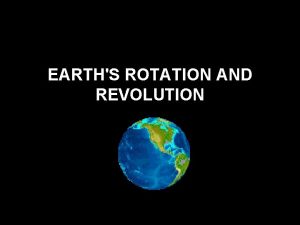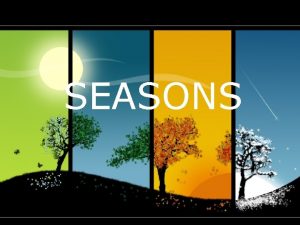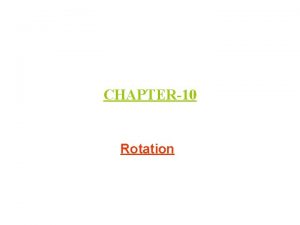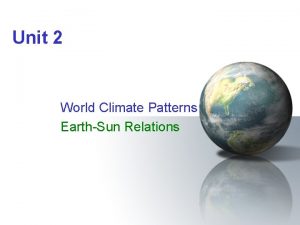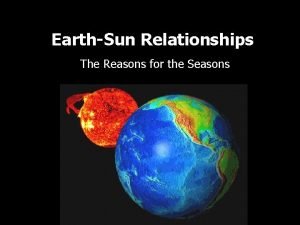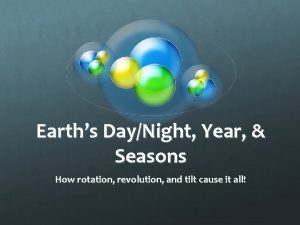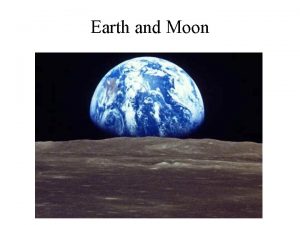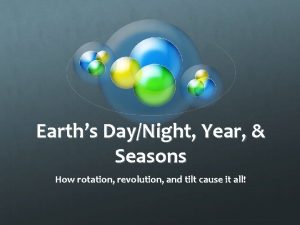EARTHSUN RELATIONS Rotation Revolution Seasons 1232020 c Vicki
































- Slides: 32

EARTH-SUN RELATIONS Rotation, Revolution, Seasons 12/3/2020 (c) Vicki Drake, SMC 1

EARTH’S ROTATION n n The Earth rotates on its axis One complete rotation (3600) takes approximately 24 hours • Rotation is from West to East n Sun appears to ‘rise’ in East and ‘set’ in West • Rotation speed is variable n 12/3/2020 Fastest at the equator (c) Vicki Drake, SMC 2

EARTH’S REVOLUTION ABOUT THE SUN n The Earth revolves about the Sun • One complete revolution takes 365. 2422 days 365 days, 5 hours, 48 minutes, 36 seconds n Approximately 365 ¼ Earth days n n The Earth’s revolution is slightly elliptical, not circular • Direction of revolution is counterclockwise from an outer space perspective 12/3/2020 (c) Vicki Drake, SMC 3

AXIS TILT AND REVOLUTION n Earth moves in a constant plane – Plane of the Ecliptic – in its revolution about the Sun • All the planets (and even the sun) are moving in the Plane of the Ecliptic n n Earth’s axis is tilted about 23. 50 from perpendicular to Plane of Ecliptic Earth’s tilt has two characteristics: • Angle of inclination • Parallelism 12/3/2020 (c) Vicki Drake, SMC 4

ANGLE OF INCLINATION AND PARALLELISM n The angle of inclination, the tilt of 23½ degrees, is a constant. • The angle does not change throughout the entire revolution n Parallelism means the axis is always pointed in the same direction • The axis does not point in different directions as the Earth moves in its orbit 12/3/2020 (c) Vicki Drake, SMC 5

EARTH’S ELLIPTICAL REVOLUTION n n The Earth, in its elliptical revolution, has an average distance of approximately 93, 000 miles from the Sun At two points in the revolution, the distance varies • Perihelion: Earth is closest to Sun, ~91. 5 million miles • Aphelion: Earth is farthest from Sun, ~95. 5 million miles 12/3/2020 (c) Vicki Drake, SMC 6

PERIHELION AND APHELION 95, 500, 000 miles 91, 500, 000 miles 12/3/2020 (c) Vicki Drake, SMC 7

PERHELION AND APHELION DATES n Perihelion occurs on, or about, January 3 • Northern Hemisphere Winter n Aphelion occurs on, or about, July 4 • Northern Hemisphere Summer 12/3/2020 (c) Vicki Drake, SMC 8

PERIHELION n n n At Perihelion, the Earth’s orbit is the closest to the Sun. The Northern Hemisphere is ‘tilted away’ from the sun, receiving less solar radiation, with shorter daylight hours. This is the Winter period for the Northern Hemisphere. 12/3/2020 (c) Vicki Drake, SMC 9

PERIHELION 12/3/2020 (c) Vicki Drake, SMC 10

APHELION n n n At Aphelion, the Earth’s orbit is furthest away from the Sun. The Northern Hemisphere is ‘tilted toward’ the Sun, resulting in more solar radiation, and longer daylight hours. This is the Northern Hemisphere Summer period. 12/3/2020 (c) Vicki Drake, SMC 11

APHELION 12/3/2020 (c) Vicki Drake, SMC 12

Changes in Axis Orientation, Tilt and Revolution n n Orientation of Earth’s axis changes during a 23, 000 -year cycle called precession The Earth’s degree of tilt (obliquity) changes through a 41, 000 -year cycle – ranging between 22. 5 and 24 degrees Earth’s orbit (revolution) about the Sun changes from nearly circular to elliptical and back every 100, 000 years – this process is called eccentricity Milankovitch Theory: these changes can be linked to long-term climate changes based on latitudinal differences in insolation (incoming solar radiation) 12/3/2020 (c) Vicki Drake, SMC 13

CIRCLE OF ILLUMINATION n n During rotation, at any given time, half of the Earth is receiving solar radiation – daylight The other half of the Earth is in darkness – night The ‘line’ separating day from night is the Circle of Illumination The image below illustrates the Circle of Illumination without the tilt of the axis 12/3/2020 (c) Vicki Drake, SMC 14

INSOLATION AND LATITUDES n n n Insolation: solar radiation received by the Earth (incoming solar radiation) Seasons: Variations of insolation due to spherical surface of Earth Some latitudes receive more insolation: • Angle of incidence • Duration 12/3/2020 (c) Vicki Drake, SMC 15

INSOLATION AND LATITUDES n Only one latitude, at any time during Earth’s revolution, receives insolation at right angles at noon • The subsolar point on the Earth • Zenith Angle for Sun n Intensity of insolation measured by using Sun’s zenith angle Subsolar point • Sun’s angle above horizon at local noon n The angle at which Sun’s rays strike Earth’s surface determines amount of insolation • More direct angle = greater insolation 12/3/2020 (c) Vicki Drake, SMC 16

LATITUDES and SUN RELATIONS n The following three latitudes are important because of their significance to seasons on the Earth • n Equator: 00 • • n n On certain days of the year (Equinoxes and Solstices), the Sun’s Zenith Angle, at local noon, will be 900 above one of these latitudes an imaginary line on the Earth's surface equidistant from the North Pole and South Pole that divides the Earth into a Northern Hemisphere and a Southern Hemisphere Two days per year (Autumnal Equinox: September 21, 22 and Vernal Equinox: March 20) the Sun’s location, at local noon is directly over the Equator Tropic of Capricorn: 23½ 0 South • One day per year (Winter Solstice: December 21, 22) the Sun’s location, at local noon, is in the Capricorn constellation Tropic of Cancer: 23½ 0 North • One day per year (Summer Solstice: June 21, 22) the sun’s location, at local noon, is in the Cancer constellation ---------------------------------------n Arctic Circle: 66½ 0 North • n marking the southern limit of the area where the sun does not rise on the Northern Hemisphere winter solstice (December 21) or set on the summer solstice (June 21) Antarctic Circle: 66½ 0 South • 12/3/2020 marks the northern limit of the area where the Sun does not set on the Southern Hemisphere summer solstice (December 21) or rise on the winter solstice (June 21) (c) Vicki Drake, SMC 17

ZENITH ANGLE AND LATITUDES – WITHOUT TILT 66 1/20 N 23 1/20 N 00 23 1/20 S 66 1/20 S 12/3/2020 (c) Vicki Drake, SMC 18

SOLSTICES, EQUINOXES, AND LATITUDES: NORTHERN HEMISPHERE BIAS! n Summer Solstice: Sun’s Zenith Angle of 900, at noon, is located at Tropic of Cancer, 23. 50 (23 ½ 0) North • On or about June 21, 22 n Winter Solstice: Sun’s Zenith Angle of 900, at noon, is located at Tropic of Capricorn, 23. 50 (23 ½ 0) South • On or about December 21, 22 n Vernal Equinox and Autumnal Equinox: Sun’s Zenith Angle of 900, at noon, is located at the Equator, 00 • On or about March 20 and September 21, 22 respectively 12/3/2020 (c) Vicki Drake, SMC 19

SUMMER SOLSTICE n n n Summer Solstice, June 21, 22 Northern Hemisphere is tilted towards the Sun Latitudes higher than 66. 50 North receive 24 hours of sunlight Latitudes higher than 66. 50 South receive 24 hours of night Longest period of daylight for one day in year for Northern Hemisphere latitudes • First day of Summer: Northern Hemisphere 12/3/2020 (c) Vicki Drake, SMC Vertical rays of Sun at noon 20

WINTER SOLSTICE n n n Winter Solstice, December 22 Northern Hemisphere tilted away from the Sun Latitudes higher than 66. 50 North receive 24 hours of night Latitudes higher than 66. 50 South receive 24 hours of daylight Longest period of night for one day for Northern Hemisphere latitudes • First day of Winter: Northern Hemisphere 12/3/2020 (c) Vicki Drake, SMC Vertical rays of sun at noon 21

EQUINOXES: VERNAL, AUTUMNAL Sun’s vertical rays at noon 12/3/2020 (c) Vicki Drake, SMC 22

VERNAL (SPRING) EQUINOX n n n Vernal Equinox, March 20 Zenith Angle of Sun at noon is 900 above Equator Day and night are of equal length at all locations on the Earth First day of Spring, Northern Hemisphere Calendar (including specific dates) and even monuments based on Vernal Equinox • For example: the Council of Nice decreed in 325 A. D. that "Easter was to fall upon the first Sunday after the first full moon on or after the Vernal Equinox” • Julian and Gregorian Calendar • Early Egyptians built the Great Sphinx so that it points directly toward the rising Sun on the day of the Vernal Equinox. 12/3/2020 (c) Vicki Drake, SMC 23

AUTUMNAL (FALL) EQUINOX n n Autumnal Equinox, September 22 Zenith Angle of Sun at noon is 900 above Equator Day and night are of equal length at all locations on the Earth First day of Fall, Northern Hemisphere 12/3/2020 (c) Vicki Drake, SMC 24

SEASONS AND EARTH’S REVOLUTION Direct Rays 23 1/20 N 12/3/2020 Direct Rays 23 1/20 S (c) Vicki Drake, SMC 25

CALENDARS AND SEASONS n Julian Calendar: • Introduced in 46 BC • A regular year of 365 days divided into 12 months, and a leap day is added to February every four years. n 12/3/2020 The Julian year is, on average, 365. 25 days long. (c) Vicki Drake, SMC 26

CALENDARS AND SEASONS n n Gregorian Calendar Decreed in 1582 by Pope Gregory • Equinox and solstices almost two weeks early on Julian Calendar • Pope Gregory dropped 10 days from calendar to put equinoxes and solstices back on track. n n October 4 followed by October 15 Changes in Gregorian Calendar • Add extra day to month of February every four years: “Leap Year” • Exception - only century years divisible by 400 become leap years 12/3/2020 (c) Vicki Drake, SMC 27

SEASONS n Distance between Earth and Sun NOT a determinant of seasons • Perihelion occurs during Northern Hemisphere winter n Determinant # 1: Angle of Incidence of Sun’s rays striking Earth’s surface • Latitudes receiving more perpendicular rays receive more insolation for heating n Determinant # 2: Length of daylight hours • Longer daylight hours means more insolation n Determinant # 3: Angle of Incidence and length of daylight hours directly affected by tilt of Earth’s axis 12/3/2020 (c) Vicki Drake, SMC 28

ANGLE OF INCIDENCE INSOLATION The more vertical the rays of Sun means a more concentrated amount of solar radiation for a location. 12/3/2020 (c) Vicki Drake, SMC 29

ANALEMMA – MAPPING THE SUN’S MOVEMENT n An analemma traces the annual movement of the Sun on the sky. • It illustrates the positions of the Sun at the same time of day (at approximately 24 hour intervals) and from the same location on Earth on successive days through the calendar year. • This apparent shift of Sun’s position is due to the Earth’s orbit about the Sun • An analemma appears as a ‘loopy’ figure eight n n 12/3/2020 the highest point is Summer the lowest point, Winter (c) Vicki Drake, SMC 30

ANALEMMA 12/3/2020 (c) Vicki Drake, SMC 31

ANALEMMA n The Analemma has a calendar printed on it • This calendar indicates which latitude (subsolar point) receives the Sun’s direct rays at noon (“Zenith Angle”) on any day of the year. n n The most northern latitude is 23. 50 North The most southern latitude is 23. 50 South 12/3/2020 (c) Vicki Drake, SMC 32
 Why do we have seaosns
Why do we have seaosns What causes night and day? *
What causes night and day? * Split traction table
Split traction table Rotation causes seasons true or false
Rotation causes seasons true or false Earth's revolution and seasons
Earth's revolution and seasons Optical activity
Optical activity Rotation versus revolution
Rotation versus revolution Earth from moon
Earth from moon Whats the difference between rotation and revolution
Whats the difference between rotation and revolution Video on rotation and revolution
Video on rotation and revolution Rotation and revolution
Rotation and revolution Crescent moon symbolism
Crescent moon symbolism Rotation vs revolution
Rotation vs revolution Define rotation and revolution
Define rotation and revolution Revolution rotation difference
Revolution rotation difference Employee relations in public relations
Employee relations in public relations Vicki freeman
Vicki freeman Vicki bosanko
Vicki bosanko Vicki farnsworth
Vicki farnsworth Vicki fleming
Vicki fleming Vicki evans
Vicki evans Vicki freeman
Vicki freeman Vicki douglas juvenile center
Vicki douglas juvenile center Vicki kijewski
Vicki kijewski Vicki nixon
Vicki nixon Vicki bernard
Vicki bernard Mlambert customer service
Mlambert customer service Vicki rundle
Vicki rundle Vicki amon-higa
Vicki amon-higa Vicki carolin
Vicki carolin Vicki turetsky
Vicki turetsky Math learning center wvu
Math learning center wvu Green revolution vs third agricultural revolution
Green revolution vs third agricultural revolution

